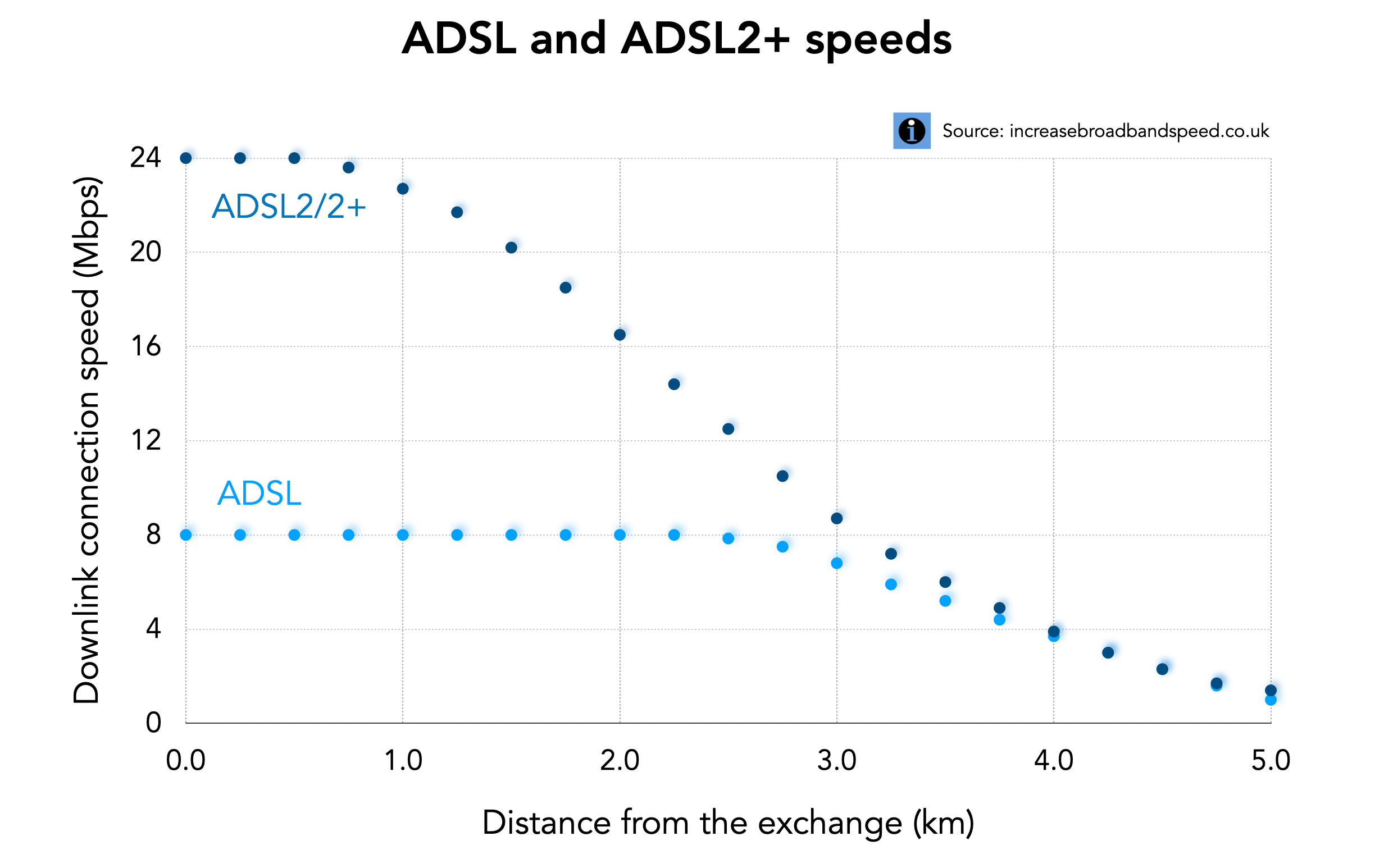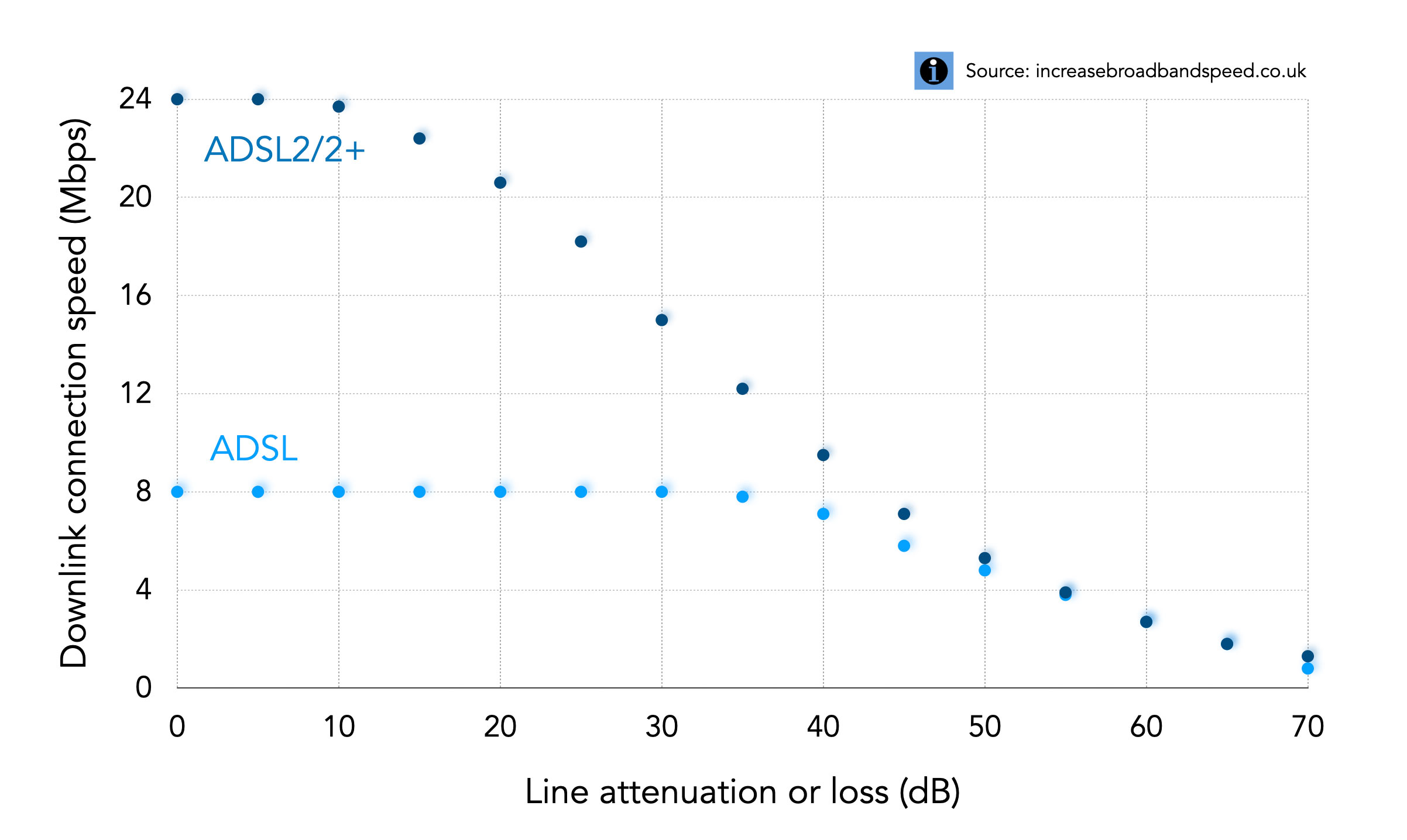ADSL2 and ADSL2+ are enhancements to the original ADSL broadband technology and can provide higher speeds, particularly for those who live close to the BT exchange. ADSL2/2+ technology is now available to 98% of UK homes and premises. The maximum possible downlink connection speeds for ADSL2/2+ is 24 Mbps, which is substantial higher than the 8 Mbps maximum for ADSL. The term ‘ADSL2+’ is often used on its own, but equipment capable of supporting ADSL2+ will also support ADSL2.
The key difference between ADSL2 and ADSL2+ is that ADSL2+ uses twice as much bandwidth along copper wires as ADSL2 does. ADSL2 uses exactly the same bandwidth as ADSL. Usually, equipment in the exchange decides on the operating mode to use, with ADSL2+ giving the highest speeds (due to its wider bandwidth) although this makes it more susceptible to line problems. If reliable operation at the wider bandwidth is not possible, the exchange equipment may force operation using the ADSL2 mode. ADSL2+ is generally the preferred mode of operation for shorter distances (from the exchange) and ADSL2 is generally the preferred mode of operation for longer distances.
Users with a line loss of over 55 dB (which corresponds to a distance from the exchange of about 4 km) will generally benefit, as detailed in our Chart of ADSL and ADSL2+ speed versus distance and Chart of ADSL and ADSL2+ speed versus line loss articles.

Chart of ADSL2/2+ and ADSL connection speed against distance from the exchange

Chart of ADSL2/2+ and ADSL connection speed against line loss
The biggest gains from ADSL2+ are achieved for broadband users located close to a BT exchange (principally due to the wider bandwidth being used with ADSL2+). For example, if you are located about 2 km from your exchange (corresponding to a line loss of about 28 dB), you could expect to double your downlink connection speed, from 8.0Mbps (ADSL) to 16.2Mbps (ADSL2+). While more distant users will not experience the same gains in absolute speeds, improvements can still be worthwhile. For example, a relatively distant user located 3 km from the exchange, and currently achieving 6.9Mbps with ADSL, could increase downlink speeds to 9.0Mbps with ADSL2+.
There may be a number of way in which you can get ADSL2+ services, which are now described.
BT has rolled out ADSL2+ services to 98% of UK premises
BT has been gradually upgrading its exchange equipment from ADSL to equipment capable of supporting ADSL2+ (also known as ’21CN’). ‘Second generation’ ADSL2+ technology is now available to 98% of UK homes and businesses. In comparison, according to BT, 99.8% of homes and businesses in the UK have access to ‘first generation’ ADSL broadband, as of June 2020.
To find out whether your exchange is currently enabled with ADSL2+, you can enter your telephone number or postcode into the SamKnows UK exchange search. Under BT Wholesale information, you will see ’21CN WBC status’. If this is ‘Enabled’, then you already have ADSL2+.
Just because you are connected to a BT exchange that has ADSL2+ capability does not mean that you are automatically connected to the ADSL2+ equipment, so you should contact your ISP to check. We recommend that you migrate to an ADSL2+ service if possible to maximise your connection speeds. Migration from ADSL to ADSL2+ could possibly incur a small charge.
Local Loop Unbundled (LLU) services offer speed ADSL2+ services
Local Loop Unbundling is the process whereby other operators (such as TalkTalk and Sky) place their own equipment in BT exchanges so that they can offer their own services with more control. LLU services use ADSL2+ technology so can offer superior speeds to older ADSL technology.
You can check to see if LLU services are available from your exchange by entering your telephone number or postcode into the following:
If BT ADSL2+ or LLU services are not available from your exchange, you will have to rely on basic ADSL technology. With ADSL2/2+ now available on BT exchanges serving 98% of UK premises, this is, thankfully, an issue being faced by fewer and fewer broadband users.
What you can do if you are unhappy with your ADSL2/2+ performance
If you are unhappy with your current broadband speeds and are unable to upgrade to superfast or ultrafast broadband, then there’s lots you can do to improve performance and speeds. As described in detail in our Increase Broadband Speed Guide, you may be able to significantly improve ADSL and ADSL2/2+ speeds and reliability by:
- fitting a filtered faceplate
- locating your modem next to the master socket, avoiding the use of extension cables
- tweaking the target ‘SNR margin’ using an equipped modem
- implementing quality of service with Smart Queue Management in your router to ensure important traffic is prioritised
- upgrading your equipment
- connecting devices by Ethernet cable, where possible, rather than using WiFi
- optimising WiFi (by using 5 GHz rather than 2.4 GHz, utilising multiple Access Points and manually choosing channels).
Other pages you may be interested in:
Blog | Increase Broadband Speed Guide | Which Router? | Guide to Fixing Bufferbloat | WiFi Set Up and Optimisation Guide
